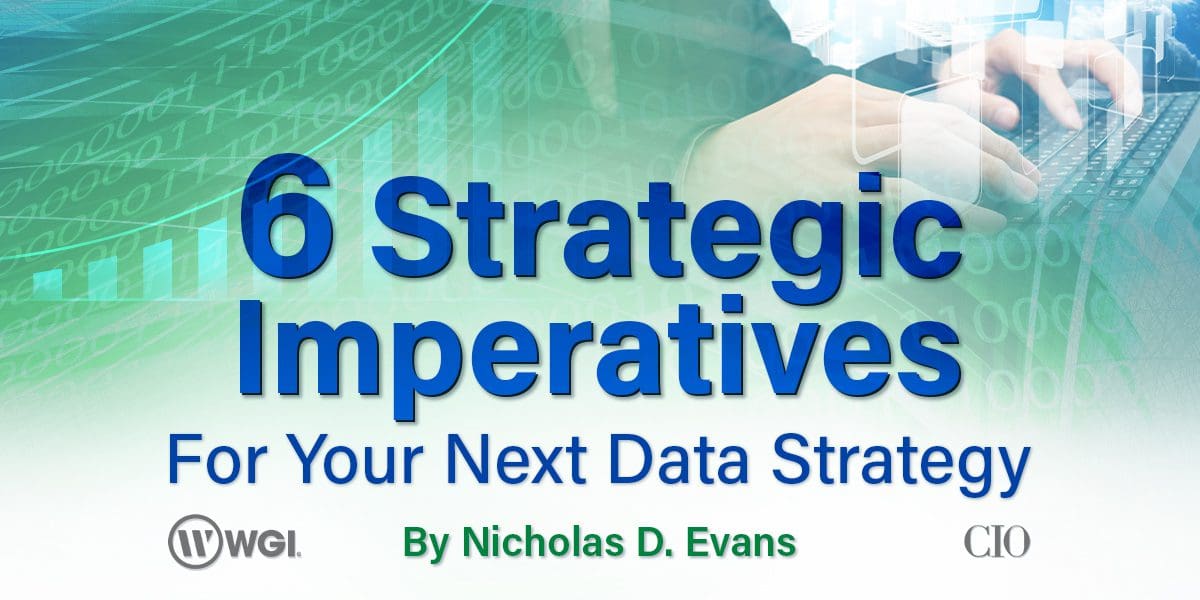By Nicholas D. Evans
As a dominant tech trend, AI has created an early-mover advantage for the data strategies that fuel it, and the business strategies that leverage it.
According to the MIT Technology Review Insights Survey, an enterprise data strategy supports vital business objectives including expanding sales, improving operational efficiency, and reducing time to market. It can also help organizations enter new product or service markets, as well as improve innovation, maintenance of physical assets, and ESG.
The problem is today, just 13% of organizations excel at delivering on their data strategy. Typical barriers include well-known data silos and duplication together with further systemic issues of limited, poor quality, and hard-to-access data.
As you plan your next data strategy, here are six strategic imperatives that will help connect your strategy to the business.
Align with and empower the technology business strategies
As with most tech-specific strategies, it’s vital to connect it into the over-arching IT and business strategies. Not only should the data strategy be cognizant of what’s in the IT and business strategies, it should also be embedded within those strategies as well, helping them unlock even more business value for the organization.
According to Sam Ansari, CEO at data engineering and machine learning (ML) platform Accure, in the current digital era, data has evolved from being a mere byproduct to the pivotal fuel that propels innovation and drives business success. By strategically utilizing data, organizations gain a competitive edge, unlocking opportunities for growth. CIOs should prioritize an adaptable technology infrastructure that eliminates data silos, ensures security and governance, and embraces a unified horizontal platform for streamlined data management, reducing integration complexities, skilled workforce requirements, and costs.
Explore ways to monetize data
In many industries, depending on how your customers consume and extract value from your products and services, your data can be monetized across multiple layers in the tech stack, from raw data itself and data with various forms of post-processing applied for added insights, to data consumed via visualization and analytics tools, and data consumed via industry applications such as digital twins.
In the architecture, engineering and construction (AEC) industry, for example, these scenarios might include geospatial data like aerial imagery offered directly via an ecommerce-enabled website, drone-based photogrammetry of roadways and bridges with AI-enabled defect analysis, like Manam, traffic congestion data visualized via a GIS platform, like Urban SDK, or EV charging data provided by a live digital twin.
The focus here should be on considering all ways your customers currently consume data as well as new ways they might want to achieve better results. For example, although the recent I-95 bridge collapse in Philadelphia was an unforeseeable event, legacy bridge management systems can likely benefit from being augmented with AI-defect analysis, or even upgraded or replaced with live digital twin platforms for a past, present, and future model.
Utilize automation, data analytics, and AI/ML
Many of today’s modern data platforms go beyond the traditional relational database, data warehouse, and data mart to provide built-in support for automation and AI/ML. There are also no-code data engineering and AI/ML platforms so regular business users, as well as data engineers, scientists and DevOps staff, can rapidly develop, deploy, and derive business value.
By placing these platforms at the core of your data architecture, your organization can get a springboard into automation, analytics and AI/ML projects while rounding it out with additional partners and investments to complete your ecosystem.
Integrate various data sources
Integrating data sources is another strategy to provide added insights for clients, and can be achieved via 2D environments such as analytics dashboards and GIS, or 3D environments like digital twins with XR capabilities for visualization, such as Magic Leap and Apple Vision Pro.
Look for opportunities to combine your own data with third-party data, including open data, where applicable, for added value and for tools that support data ingestion, transformation, and integration to feed into a variety of analysis tools including GIS and digital twins.
Make data intrinsic to the product and services portfolio
As we explored in 5 measures to gauge your digital portfolio maturity, data and analytics can be an intrinsic part of your product and services portfolio. So much, in fact, that it’s worth measuring what percentage of your portfolio utilizes data and analytics as part of the offering, and tracking this over time. A great way to get started is to work with your divisions and departments to have them self-assess their current percentages, and then determine where they’d like to be in 2025 or beyond based on your organization’s digital strategy.
How data can turn projects into products for annuity revenues
If your organization provides consulting services, then revenues are often driven by one-off projects, and average revenue per FTE is limited by engagement sizes and bill rates that are prevalent in the market. By incorporating data into your deliverables, you can often turn this into an annuity revenue stream where these projects become software products to monetize via a SaaS business model.
Even physical assets can be monetized this way. The asset purchase is a one-time transaction, but the data surrounding that asset during its daily operation can be monetized throughout its lifetime. As consulting firm Cognizant famously highlighted, even the usage data that swirls around an everyday product of $50 or more, such as an electric toothbrush, can be monetized in this manner.
Of course, no set of imperatives for a data strategy would be complete without the need to consider people, process, and technology. Here, we’ve covered the business imperatives, but to enable this requires a broader set of technical imperatives and considerations (like data quality and hygiene), as well as resource imperatives and considerations (including data skills, competencies, and training). Spending time on your next data strategy, and how to monetize and extract value internally, will pay dividends toward your automation and AI strategy, and your overall IT and business strategies.
To access the original article, please click here.



















